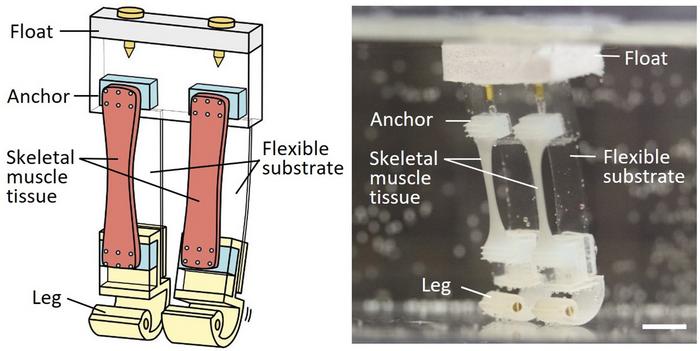Forget nuts and bolts. Japanese scientists have created a two-legged “biohybrid robot” that combines living biological muscle with an artificial skeleton.
To create the robot, researchers at the University of Tokyo grew skeletal muscle in molds to create strips. They then fashioned the lightweight skeleton out of styrene board, a flexible silicone-based body, acrylic resin legs with brass wire weights, and 3D-printed feet.
The strips of muscle tissue were then fixed along the body to the feet of the robot, not dissimilar to how they’re attached to an animal’s bone.
With a jolt of electricity, the robot can slowly move forward and turn within a small circle.
“Initially, we weren’t at all sure that achieving bipedal walking was possible, so it was truly surprising when we succeeded. Our biohybrid robot managed to perform forward and turning movements with a bipedal walk by effectively balancing four key forces: the muscle contractile force, the restorative force of the flexible body, the gravity acting on the weight, and the buoyancy of the float,” Professor Shoji Takeuchi, study author from the Graduate School of Information Science and Technology at the University of Tokyo, said in a statement.
Don’t expect a graceful gait from the robot just yet. The current model is only capable of nudging around by pivoting on its two “limbs,” which it achieves at an achingly slow speed of just 5.4 millimeters per minute. It’s only capable of working underwater, as the lab-grown muscle dries out quickly when exposed to air.
Nevertheless, the new research project shows roboticists are overcoming a major hurdle with biohybrid robots, which currently can move in straight lines or perform large turns.
These early steps in creating “biohybrid robots” are part of scientists’ interest in using examples from living organisms to create smarter and smoother robots.
“By incorporating living tissues as part of a robot, we can make use of the superior functions of living organisms,” explained Takeuchi.

Labeled illustration and image of the “biohybrid robot”.
Image credit: ©2024, Kinjo et al/ Matter
“We’re working on designing robots with joints and additional muscle tissues to enable more sophisticated walking capabilities. Our findings offer valuable insights for the advancement of soft flexible robots powered by muscle tissue and have the potential to contribute to a deeper understanding of biological locomotion mechanisms, further enabling us to mimic the intricacies of human walking in robots,” Takeuchi added.
Beyond pure robotics, many other scientists are looking into ways to meld living structures with technological systems. Just a few weeks ago, researchers at Indiana University Bloomington unveiled a computer chip that was fused with human brain tissue, creating a mini hybrid cyborg in a Petri dish that can perform math equations and recognize speech.
The study is published in the journal Matter.
Source Link: Watch A Hybrid Robot With Living Biological Muscles Wander Through Water